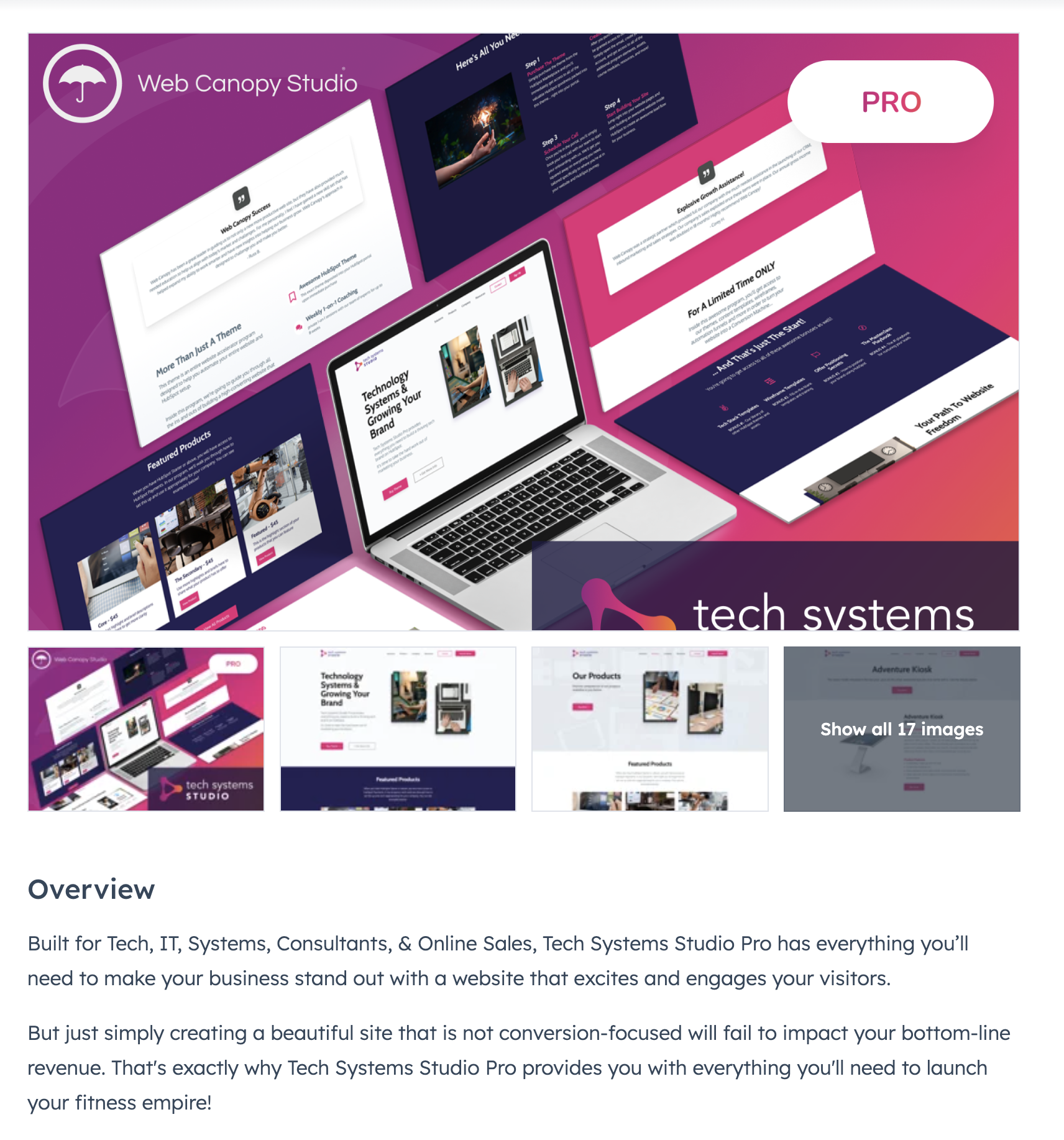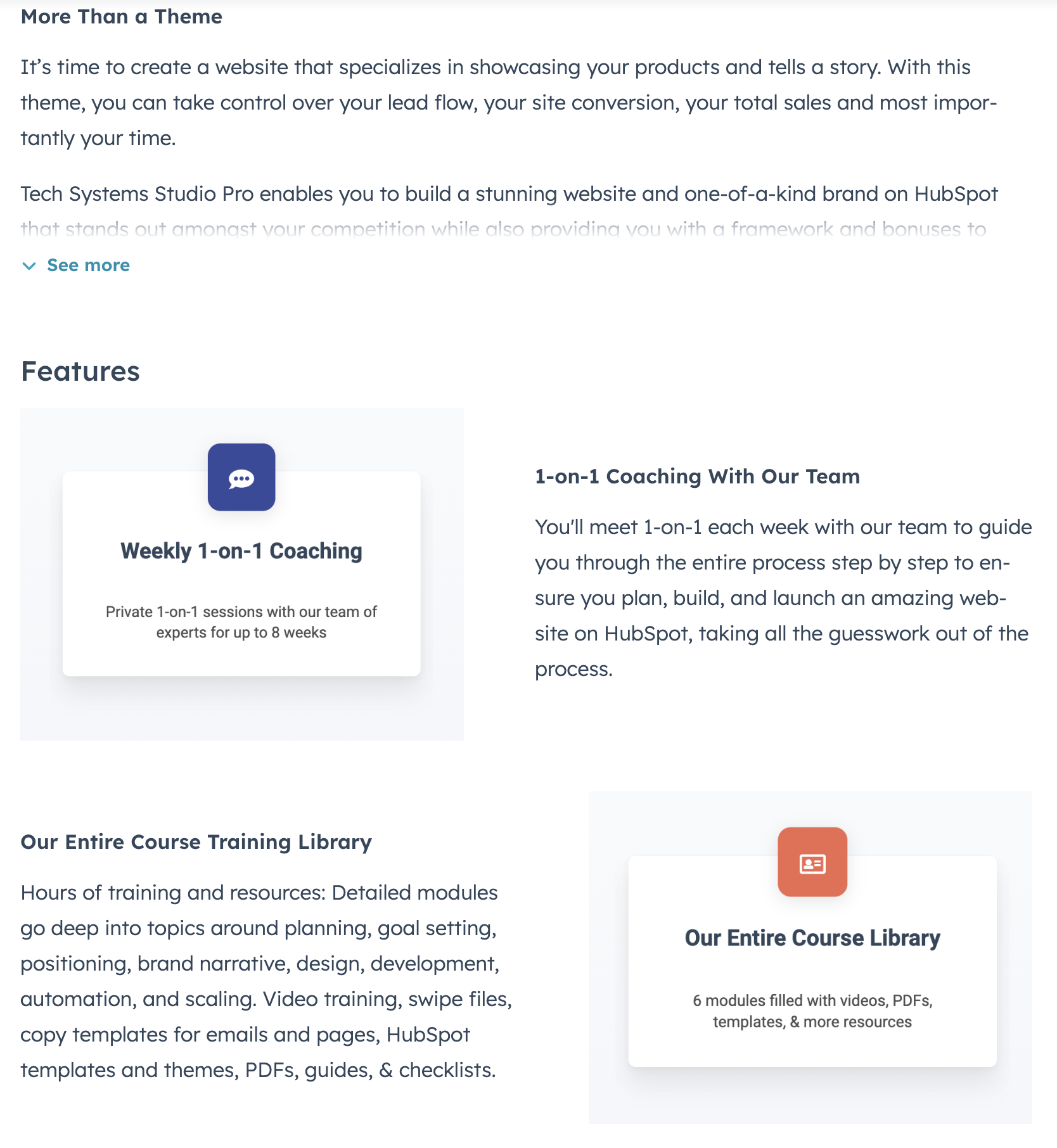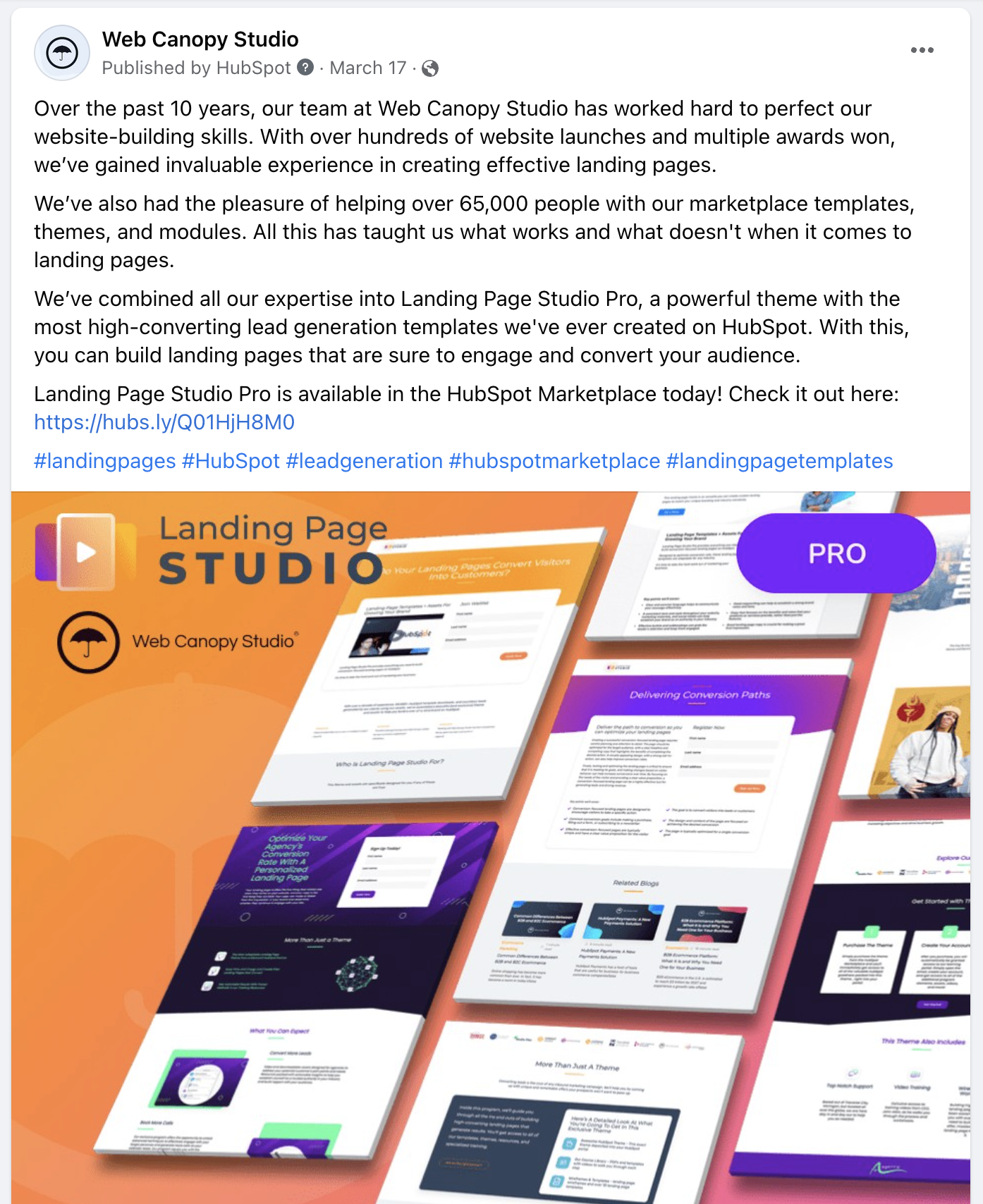An abbreviated version of this blog can be found posted on the HubSpot Developer Blog here. Here is the full-length blog:
"Launching a theme in the marketplace is an exciting time for any provider, but will it drive significant sales and revenue for your business? Will it thrive and rise to the top? In this blog post, we'll dive into the importance of not only creating a great theme, but also having an effective marketing strategy around the launch so your company can see long-term growth and success in the marketplace."
The Marketplace Blues
Let's look at a hypothetical situation that happens all too regularly. Let's say we have an agency owner named Michael. He and his team spent the last three months passionately building a theme for the Hubspot marketplace. They put their heart and soul into this project, working late nights to perfect every module and template, all while handling their regular client work. The theme was intended to be a game-changer for their business and a standout in the marketplace.
Excited and ready to get going, they submit the theme to the Hubspot marketplace, hoping to see it take off and generate downloads. However, as the first few weeks went by, the excitement and passion that Michael and his team shared begins to fade. Downloads were nonexistent, and it seemed like no one was interested in what they built. Michael and his team lost all the wind in their sails, and they started to feel the "Marketplace blues," as they realized this effort they spent so much time on was not what they had hoped it would be.
Frustrated (and maybe even a little embarrassed), Michael decided to remove the theme from the marketplace. He couldn't understand why it had performed so poorly, given the time and effort they had invested in creating a high-quality product.
The truth was, however, that the theme they built was indeed actually very cool. It was a well-designed product that many people would have loved to use.
Michael's theme didn't fail because it was a bad product; his theme failed because he didn't invest as much time and effort into marketing the theme as he did while he was creating it.
The Key To A Successful Marketplace Theme
Although Michael's story is fictional, it resonates with a large majority of providers who have added products to the marketplace over the years. And yes, that scenario happens to even the most successful providers at some point.
So what are some of the ways to get more out of your Marketplace themes and other assets? A successful marketplace theme isn't a result of mere happenstance, but rather, a combination of two strategic pillars: an outstanding product listing page, and a thoughtfully orchestrated product launch. Together, these form the backbone of a powerful marketplace presence that not only attracts potential users, but also convinces them of the value your theme brings to their businesses.
Striking the right balance between these elements isn't always easy, but when done correctly, it paves the way for higher visibility, customer interest, and increased sales.
The Product Listing And Demo Page
Imagine for a moment you're in a bustling market, like a street fair or a farmer's market in a busy city. Among rows and rows of booths, you have your own little store setup, offering a product you've painstakingly crafted. But will people come to your booth? They might, if they notice it. but if you're thrown in the mix and get lost within a sea of everyone else, you're out of luck. And, therein lies the rub.
Just like the vendors in that real marketplace, the design and positioning of your booth—in this case, the listing page—can significantly affect whether potential customers stop to examine your offerings or pass by without a glance.
A theme listing page isn't just a placeholder in the marketplace; it's the online equivalent of a window display. It's the first impression potential customers get of your theme, and we all know the power of first impressions. It should be enticing, communicating the value and functionality of your theme effectively, and encouraging visitors to explore the value.
First, you need to ensure that your theme listing page is informative and easy to navigate. The goal here is to eliminate any guesswork for your potential customers. Clearly articulate the key features, benefits, and applications of your theme. High-quality screenshots, live demos, and informative videos can be instrumental in showcasing the theme's functionality and design quality.
But it's not just about looking good; it's also about sounding good. Crafting a compelling product description is vital. This copy needs to communicate not just what your theme does, but how it solves problems for its users, and why it stands out in the crowded marketplace.
Moreover, it's essential to remember that your listing page is a part of your overall brand narrative. Consistent brand messaging across all touchpoints helps build trust and rapport with your audience. Your listing page, therefore, should align with your brand's tone, style, and values, contributing to a unified and recognizable brand presence in the marketplace.
It's also worth noting that a well-optimized listing page can enhance your theme's visibility in marketplace search results. Proper use of keywords, tags, and categories can help your theme appear in relevant searches, increasing your theme's discoverability. For a complete listing of really strong listing page recommendations, see Nick LaPorte's Best Practices for Listing a Theme or Module on HubSpot’s Asset Marketplace.
Not unlike the listing page, a robust product demo page for a website theme plays a crucial role in promoting higher sales volumes in the marketplace. Its impact can be seen in several ways:
- Showcase of Theme Features and Capabilities:
A comprehensive product demo page acts as a showcase, providing potential buyers with a clear understanding of the theme's features and functionalities. Buyers can visualize how these features can fulfill their specific needs or solve their problems. This understanding significantly increases the chances of them making a purchase decision.
- Trust and Credibility:
With a well-executed demo, you instill confidence in your potential customers. They can see for themselves the quality of your work, your attention to detail, and the practical application of your theme. This helps to build trust, credibility, and a positive brand image, which are essential for driving sales.
- Facilitates Decision Making:
The choice of a website theme is often a significant commitment for a user. They are not just buying a product; they are deciding on the visual representation and functionality of their online presence. A compelling demo page can reduce uncertainty and help expedite the decision-making process.
- Demonstrates Customizability:
A strong demo page can highlight the theme's customizability - a crucial selling point. It can show how elements can be tailored, which gives potential buyers confidence that they can adapt the theme to fit their specific brand identity and business needs.
- Reduces Purchase Risks:
A theme is an investment. By allowing potential buyers to experience the product first-hand through a demo, you're reducing the perceived risk associated with the purchase. This reassurance can be a significant factor in a buyer's decision-making process, leading to increased sales.
- SEO Benefits:
An engaging and well-structured demo page can improve search engine rankings, increasing visibility and driving more traffic to your page. The more visitors you have, the higher the probability of conversions and sales.
Your theme's listing page and demo is a bridge connecting your potential customers to your product, a stage that showcases your theme's features and benefits, and a narrative that tells your theme's story. So, as you embark on the exciting journey of launching a theme in the marketplace, remember to invest time and thought into crafting a compelling listing page—it could make all the difference between your theme blending into the background or standing out and shining.
The Product Launch
For many providers, the launch process of a theme in the marketplace is usually overlooked and often takes a backseat. One of the biggest mistakes you can make when submitting a theme to the marketplace is to assume that the launch's outcome is beyond your control. This perception couldn't be further from the truth. Providers have a significant impact on the launch process when they approach it with smart strategy for generating exposure. But how do you launch properly? For an answer to that, we can leave the digital world for a moment and look at the real world for some inspiration.
The launch of a theme is similar to a grand opening festivities of a brick and mortar store. You wouldn't expect people to just wander in if they didn't know you were open for business, right? Especially if they've never heard of the company and didn't know what the store was all about. Similarly, a well-executed product launch helps you make a grand entrance into the marketplace, grabbing the attention of your target audience, and stirring up interest for your theme. This is your chance to make a solid first impression and establish your theme's presence.
A product launch is not only about announcing your theme to the world, but also communicating its value proposition. Remember our friend, Michael, from the earlier example? His agency had invested significant time and resources into crafting a beautiful theme. However, upon launch, they found that downloads were few and far between. The problem wasn't the quality of their theme; instead, it was a failure to communicate why their theme was different and worth downloading, and not building enough hype and excitement in the pre-launch and post-launch exposure.
Rethinking The Launch Date
There's a crucial factor that can radically shape the outcome of your launch, and that is rethinking the definition of the 'launch date.' Traditionally, many providers think of this as the day their product goes live in the marketplace. However, this approach can limit the opportunity to generate momentum and build hype around the product.
Instead, providers should think of the launch date as the culmination of a well-executed pre-launch runway - a carefully thought-out plan designed to maximize the product's market impact. This plan starts taking effect weeks, sometimes months, before the product goes live in the marketplace, building up hype and anticipation in the run-up to the official launch.
Building an effective pre-launch runway involves the following:
- Setting a Tentative Launch Date: Provide a contingency period of approximately two weeks after the day your product is expected to go live on the marketplace. This period allows for necessary theme revisions, ensuring your product is refined to its best possible version when it reaches the public.
- Creating a Pre-Launch Content Calendar: Plan and schedule a series of engaging content pieces that will be disseminated in the weeks leading up to the launch. This could include blog posts, emails, social media posts, videos, webinars, or podcasts.
- Generating Hype: The aim of your pre-launch content should be to generate as much hype as possible about your product. Discuss the problem your product solves, reveal teasers or sneak peeks of your product, and create an air of anticipation around the launch date.
- Promoting Exclusivity: Offer your audience the option to be notified when the product is ready. This not only creates a sense of exclusivity but also builds a pool of potential customers who've already shown interest in your product.
The pre-launch strategy sets the stage for your product's arrival in the marketplace. Make sure it doesn't just quietly appear, but rather, is welcomed with anticipation and interest.
Leveraging Your Audience
In addition to rethinking the launch date and building an effective pre-launch runway, another crucial aspect of a successful product launch is leveraging your existing audience. This includes your network on social media platforms, your email subscribers, and any potential collaborations or partnerships you might have.
Your existing audience is one of the most valuable assets you possess when launching a product. They are already familiar with your brand and may be more inclined to support your new product. Here's how you can effectively leverage your audience:
Engage Your Social Media Network
Share regular updates about your upcoming product on your social media platforms. Build excitement by discussing the product's features, the problem it solves, and teasers leading up to the launch.
Utilize Your Email List
Your email subscribers are a ready audience interested in your offerings. Engage them with valuable content and exclusive previews of the upcoming product. Offer them the option to be notified when the product is ready, fostering a sense of exclusivity and anticipation.
Collaborate and Partner Up
If you have relationships with other brands, influencers, or industry figures, consider collaborative promotions for your launch. This can help you reach a wider audience and bring more attention to your product.
Remember, a successful product launch is as much about the audience as it is about the product itself. Effectively leveraging your audience helps your product garner more attention at launch and maximizes your impact.
The Pre-Launch Content Strategy
The pre-launch content strategy plays a pivotal role in creating hype and anticipation for your product. It is the mechanism that not only informs but also engages and entices your audience. It lays the foundation for your product's narrative, underscoring the problem it solves and the unique value it brings.
Each piece of content is a brick in the runway leading up to the launch, and every platform or delivery method is crucial in reaching different segments of your audience. Here are just a few of the key content pieces you can produce and how each could help:
- Blogs: Blog posts are best used for in-depth discussions about your product, including its features, benefits, and the problems it solves. They offer a space to weave an engaging narrative around your product, and they're easily shareable, boosting your product's visibility.
- Podcasts: Podcasts are increasingly popular and provide a conversational platform for discussing your upcoming product. Hosting a podcast series around your product's domain could pique interest and keep your product top of mind as the launch approaches.
- Webinars: A pre-launch webinar allows you to interact directly with your audience, fielding questions, and building anticipation. Use webinars to offer sneak peeks or live demos of your product, giving your audience a firsthand look at what's coming.
- Social Media: The interactive nature of social media platforms makes them perfect for sparking conversations and excitement about your product. Utilize different types of posts - images, videos, stories, or live streams to keep your audience engaged and eagerly anticipating the launch.
- Live Videos: Platforms like Facebook and Instagram allow you to connect with your audience in real-time, answering questions, and offering live demonstrations of your product. This interactive experience fosters a deeper connection with your audience and personalizes the hype around your product.
- Email Campaigns: Emails let you directly reach out to your subscribers, providing them exclusive updates, sneak peeks, and special offers related to your product. A well-timed email campaign can significantly boost anticipation for your launch.
Ideas For Pre-Launch Content
When it comes to pre-launch content, the key is to engage, excite, and involve your audience. You want them to feel like they're part of the journey leading up to the launch. Here are some content ideas to get the gears turning:
Sneak Peeks and First Looks
Give your audience exclusive previews of your product. This could be in the form of blog posts, social media updates, or email newsletters. This creates a sense of exclusivity and anticipation.
Behind-the-Scenes Content
Show your audience what's happening behind the scenes as you prepare for the launch. This could include product development, team meetings, or design processes.
Interactive Content
Get your audience involved. For example, you could run a logo design vote on social media where people vote for their favorite, or hold a contest where the winner gets a free copy of the product upon launch.
Problem-Solving Content
Focus on the problem that your product solves. This could be a blog post discussing the issue in depth, a podcast interviewing industry experts, or social media posts sharing customer testimonials.
Remember, every piece of content you produce should serve to build hype and anticipation for your product launch. By engaging your audience and getting them invested in your product, you set the stage for a successful launch.
Utilizing The Free Theme Model
Free themes are a very popular way to generate traction in the marketplace. Listing free assets in the HubSpot marketplace as a provider can have its own set of disadvantages, however. Let's explore the pros and cons of offering free HubSpot themes.
The Upsides of Free Themes
Obviously, the biggest advantage here is the overall volume you can open the door to. Free themes can drastically amplify your exposure. A free theme is a magnet for a diverse set of users, drawing in individuals who might be hesitant to invest in a paid theme immediately. This broad audience gives you a wealth of feedback and the chance to fine-tune your work. This practice does tend to lean more toward novice level users who are downloading your product, which, if nurtured appropriately, can help you build authority, trust, and strong relationships with them as you guide them through their HubSpot journey.
Secondly, a free theme can be an interactive business card in the marketplace. It's a live demonstration of your skills, showcasing your abilities to potential clients who might be encouraged to try your free offering. If they appreciate your work, they're likely to consider your premium themes or services in the future, creating a trust-filled relationship.
Finally, free themes could be an effective lead generation tool. You can introduce a basic theme for free, with the strategy to upsell premium features or services. This tactic can attract users to your offerings and create a potential customer base. [link to other article I wrote]
The Downsides of Free Themes
Despite the benefits, offering free themes also presents some challenges. Primarily, your immediate revenue opportunity is non-existent until you have a solid upsell strategy or a way to monetize your free offerings.
Next, even with free themes, users might expect a high level of support. This increased demand for customer service can put additional strain on your resources, potentially outweighing the advantages if not managed effectively.
Then there's the question of perceived value. The phrase "you get what you pay for" is often taken to heart by customers. Even if your free theme is of high quality, you will certainly run the risk of users not taking it seriously because of the price, which will impact your brand's image.
Finally, there's a risk of overuse. Your free theme, once released, could be employed by countless websites. This widespread usage might lead to a lack of originality and brand distinction, potentially diluting your theme's unique appeal.
Free themes are a long-term play. If you are okay with bypassing the ability to generate immediate revenue from theme sales and can sustain the wait times that may occur for your nurturing to effectively convert users into customers, this is a phenomenal source of action in your pipeline. If not, you will likely put in a considerable amount of work for very little reward. Weigh the potential for increased exposure and reputation building against the possible revenue implications, heightened support demands, and potential perception of lower value. Make sure that your choice aligns with your business strategy and capabilities for optimum success. If you intend to launch a free theme model, make sure to thoroughly think through your nurturing and acquisition strategy, which will only be successful if you are providing value and solving problems for your users.
Indirect Results Of A Bad Launch
However, it's not always the product sales that end up being a good judge of campaign effectiveness. We built a powerful new theme in early 2023 that was one of the more exciting products we've ever built at Web Canopy Studio. We were determined to make a significant impact with the release of this theme, so we implemented a comprehensive launch campaign, adhering to the suggested outline provided earlier. This campaign featured:
- 3 blog posts on relevant topics, shared and featured on our website
- 3 podcast episodes sharing the same content
- 3 longform YouTube videos
- A social media strategy across Facebook, Instagram, LinkedIn
- 6 emails sharing similar content and launch emails
Here's a snapshot of the results from our campaign:
- 294 unique clicks from email
- 359 unique clicks from social and site links
- Total sales in the first two weeks of the theme being live: only 2, for a total of $1,000
On the surface, it seemed as though all our hard work resulted in relatively poor performance. We couldn't help but feel a bit disheartened, just like Michael in the example above.
However, this story isn't meant to discourage you. Rather, it's to demonstrate that launching themes in the marketplace can have a remarkable amplifying effect on your overall marketing efforts, even if the initial outcomes may not appear impressive. The indirect results, however, were genuinely significant.
Here's some additional data that demonstrates the broader impact of our campaign:
- Number of people who directly booked a time with salesperson from the emails: 10
- Number of email replies requesting further conversations: 12
- Number of new projects won as a result of engaging with our audience during this 4-week period: 6
These projects included:
- Previous customers who saw the emails and reached out for hourly development work on HubSpot, even though they weren't interested in the new theme
- Leads that inquired about the theme's functionality and ultimately signed an agreement for a migration and integration project on HubSpot
- Cold leads who were re-engaged and eventually signed a custom website project due to the timing being right
In the first two weeks of launching the theme, we only sold $1,000 worth of products. However, the real value of our launch campaign came from the follow-up and diligence of our team, which led to signed contracts totaling over $60,000. Without launching the theme and using it as a means to stay relevant with our audience, we may not have closed those deals.
The takeaway from this story is that, while it's essential to invest time and energy into your theme launch campaign, it's also crucial to recognize the indirect benefits that can arise from it. Beyond immediate sales, a well-executed campaign can lead to renewed relationships, fresh opportunities, and new projects with both existing and potential clients.
Navigating the marketplace journey can be thrilling, challenging, and ultimately rewarding. As theme creators, we must strive not just to produce great themes, but also to master the art of presenting and promoting them in the marketplace. By doing so, we can transform our efforts into tangible success, creating themes that resonate with our audience and stand out in the bustling marketplace. As we've discussed, the key to successfully launching a theme goes far beyond the design and coding stage.
Remember, the marketplace is not just a platform to sell themes, but a stage to tell their stories. And with the right strategy, your theme could be the next big hit.
Ready to take your marketplace launch to the next level? Get access to the free checklist called The Ultimate Roadmap To Launch A Service-Based Product With HubSpot.






